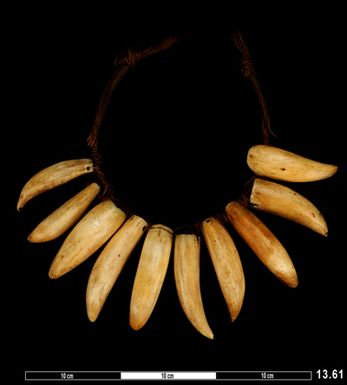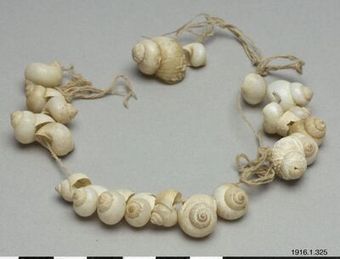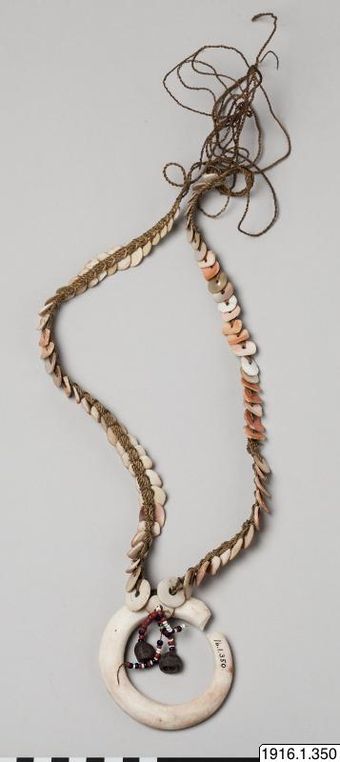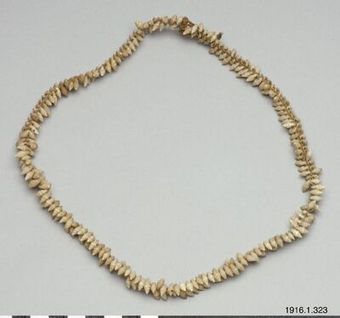Connect with Horniman Museum and Gardens
Contact this content partner to get more information about this item.
necklace
- Description:
- Necklace of Ten Whale Teeth, Sisi, Fiji, Western Polynesia. The teeth of the Sperm Whale (Physeter catodon) were of great value and cultural significance for the people of Western Polynesia, and one manifestation of that importance was the use of smaller whale’s teeth as components in necklaces. Fijian sisi necklaces such as this one, which incorporated a number of smaller Sperm Whale teeth, were among the most prized valuables in that group. When Western whaling ships, sandalwood traders and shippers of Canadian furs began to appear in the region around 1800, they found that they could supply whale’s teeth to the Fijians and Tongans in return for vast quantities of fresh fruit and vegetables, drinking water, timber and so on. Flooding the region with previously very rare ivory meant that it lost some of its value for the Fijians, but it also meant that there was more of it for craftsmen to break up for use in making their breast ornaments, necklaces, sporting darts, and inlaid shapes on clubs and headrests. The sisi always maintained its value, however, because the sheer number of whole teeth required was still enormous. The ivory-workers in Fiji were predominantly Tongan specialists (tufunga fono lei), and they developed a technique for sawing down whole teeth into finely polished long, curved points. Necklaces called waseisei could be made from these points which (in many ways) excelled the craftsmanship of the sisi, but they were always given secondary value to the sisi because the teeth were not whole. In this way, the sisi was like a little wearable string of tabua ceremonial valuables for the Fijians. Sperm whale ivory, coconut fibre. Mid-19th Century. Formerly in the private collection of Mr James Edge Partington. Ten small whole sperm whale teeth pierced and strung together into a necklace using coconut fibre.
- Format:
- image
- Collections:
- Horniman Museum and Gardens
- Content partner:
- Horniman Museum and Gardens
- Availability:
- Not specified
-
Copyright status: All rights reservedFind out more about what you are able to do with this itemThis item is all rights reserved, with means you'll have to get permission from Horniman Museum and Gardens before using it. For more information, please see our use and reuse page.More informationHorniman Museum and Gardens has this to say about the rights status of this item:
http://rightsstatements.org/vocab/InC/1.0/
What can I do with this item?Non-infringing useNZ copyright law does not prevent every use of a copyright work, and this item may be hosted by an international institute or organisation. You should consider what you can and cannot do with a copyright work.No sharingYou may not copy and/or share this item with others without further permission. This includes posting it on your blog, using it in a presentation, or any other public use.No modifyingYou are not allowed to adapt or remix this item into any other works.No commercial useYou may not use this item commercially.
Welcome and warm Pasifik greetings
The information on this site has been gathered from our content partners.
The names, terms, and labels that we present on the site may contain images or voices of deceased persons and may also reflect the bias, norms, and perspective of the period of time in which they were created. We accept that these may not be appropriate today.
If you have any concerns or questions about an item, please contact us.



